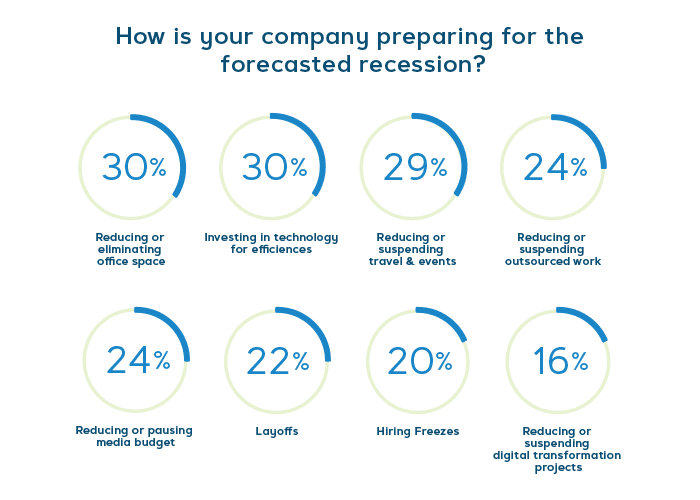Eye-opening survey data revealed 70% of middle market companies are revamping their budget over the next year with a focus on saving costs. Despite widespread cost cutting as a potential recession looms, 72% still said company growth is a high priority.
In the same survey of 500 finance professionals, 30% of respondents said they are eliminating office space and investing in tech to drive efficiency.

So, as your business braces for a recession and starts to re-evaluate costs, you should ask yourself two questions:
What can my accounts payable (AP) team do to impact the bottom line and prove itself as an asset that powers growth?
How can my AP team leverage technology to perform efficiently in a hybrid/remote environment?
In this post, we want to help you unlock five strategies that can transform an AP department from a cost center to a business driver that thrives both in the office or remotely.
5 Ways AP Departments Can Help Offset Recession Impacts
1. Ensure business continuity
The decentralization of finance teams during the pandemic and the ongoing war for talent has uncovered critical gaps in business continuity plans.
It’s vital for AP teams to maintain operation during times of turnover or other unforeseen challenges. Here are a few steps your AP team can take today to ensure it maintains efficient processes in the event a team member leaves, another is added or you’re forced to operate in a different setting:
Centralize important documents and critical operations in a digital home
Just because your workforce isn’t centralized in a single office setting doesn’t mean your financial operations can’t function out of a single, cloud-based home that makes anytime, anywhere access to documents possible.
In our latest research survey, 30% of respondents said their companies are preparing for the recession by reducing or eliminating office space. So if your team has yet to make the move to a hybrid or fully remote operation, prepare now by building an easily accessible digital home for invoice and payment execution functions.
Design custom, role-based workflows that keep approvals moving
If your team has made the move toward automation, fully capture the benefits of your software by developing custom invoice approval workflows that keep the ball moving.
These workflows allow your team to easily review and track where an invoice is in the approval process and set up reminders for approvers if an invoice sits in their queue after an allotted amount of time.
Take the process one step further by building these workflows around specific roles instead of individuals. In AvidXchange’s recent “AP Professional Career Satisfaction Survey,” 36% of respondents said they are either currently looking for a job with another organization or plan to start looking for a new job within the next six months. With that in mind, role-based workflows make it easy to onboard a new hire regardless of career level.
Address potential ‘tribal knowledge’ issues
Smaller AP teams with long-tenured employees often grapple with problems stemming from “tribal knowledge.” This happens when only one person in the AP department, for instance, has a large amount of expertise handling invoicing and payments but then goes on vacation, gets sick or resigns.
Centralizing operations, building role-based workflows and accounts payable automation software (in general) can be incredibly powerful in reducing the risks associated with tribal knowledge.
“The more manual a department is, generally, the more that individual currently in that role has all the keys to the kingdom, knows where all the bodies are buried, and probably has bootleg processes,” says Gary Larson, Director of Growth Readiness at AvidXchange. “It creates so much risk for an organization when somebody retires, or leaves, or wins the lottery, and the company has no idea what to do.
“But if automation is part of your ecosystem, the risk and volatility of being able to onboard and be effective through that volatility goes down exponentially.”
2. Closely manage costs
Inflation has increased overall spending across the board for finance departments, including wages and office supplies.
To combat this increase in spending, focus on reducing your company’s reliance to paper.
Handling paper invoices and manually entering line-item and invoice data can cost your organization time and money. Then there’s paying those invoices with paper checks, which according to Bank of America, can cost anywhere from $4 to $20 per check payment to process, inclusive of check stock, stamps, envelopes and the time spent writing, mailing, collecting and reconciling payments
Relying on paper checks may not even be as convenient or inexpensive as your company may believe.
In fact, according to the Association for Financial Professionals’ 2021 Payment and Fraud Control Survey, paper checks continue to be the top vehicle for payment fraud. The survey revealed 66% of businesses that were victims of payment fraud were targeted via paper checks.
3. Analyze data to pinpoint savings
It’s important to look into your company’s invoice and payment data to reveal opportunities for additional savings.
To help your company get started with identifying opportunities for savings, here are some signs to look for:
- Unusual increases in recurring payments or repeating charges to vendors
- Be aware of the average time and cost to process and pay each invoice
- If able, develop custom overviews and reports that provide actionable insight into spending performance
A powerful KPI to track is the average cost to process a single invoice. To calculate this, divide the cost of the total accounts payable by the total number of invoices processed each month.
The key is to include all costs, especially labor because it’s often the highest cost of all. Remember to include costs for audit fees, lost supplier discounts, mailing and printing, payment mistakes, equipment and more.
To increase efficiency and maximize savings, your AP department should assess the time spent on the manual AP processes such as typing in invoice data, reviewing materials, approvals, payments, reconciling and updates.
For example, according to Goldman Sachs, businesses typically spend up to 70% less time using AP automation compared to manual processes.
Analytics tools within an AP automation solution can also help uncover purchasing patterns, like what is being purchased, by whom, from which suppliers and with what frequency. With that knowledge, procurement teams could consider grouping purchases together to get a volume discount or consolidating similar purchases with a single, lower-cost supplier.
4. Capture early payment benefits
Greater overall efficiency in the invoice approval process helps your business take advantage of early payment discounts.
Buyers may receive early payment discounts in exchange for paying a supplier’s invoice before the due date. Essentially, a company pays less than the full amount and the supplier receives payment earlier than they typically would — a win-win.
For suppliers, one advantage to an early payment discount is, of course, that they’re paid earlier than they typically would be — this accelerates their cash flow. Another plus is often when suppliers offer early payment discounts they are rewarded with more business.
AP teams should contact their vendors on a regular basis to ask about early payment discounts that can benefit both parties involved in the transaction.
With enough volume, these payment benefits can increase your company’s financial health, while establishing stronger supplier relationships.
VIDEO: How Middle Market Finance Teams are Preparing for a Recession
5. Improve vendor management
A strong relationship between buyer and supplier does not happen overnight. It requires the two parties to invest the time and money needed to understand each other’s needs more clearly.
Here are the five ways in which your company can improve their vendor relationships:
- Share goals and priorities – establish clear and measurable goals that are rank-ordered for prioritization
- Identify and choose the top vendors – identify the vendors most likely to fulfill your company’s goals, taking into account your company’s most acceptable amount of risk
- Negotiate toward win-win outcomes – understand that the best scenario during a contract negotiation is to arrive at mutually agreeable terms that meet the needs of both parties involved (your company and your suppliers)
- Monitor KPIs and maintain communication – do not take for granted that suppliers will perform to the standards of your contracted terms
- Invest in the right tools – identify the technology that will best support the goals of your company and the supplier
For a buyer-supplier relationship, the right technology can organize supply chain data, save time and avoid frustrating payment delays, manage master vendor files automatically and help both organizations assess performance metrics.
So, is your AP team prepared for a potential recession?
Our latest research shows middle market companies are reevaluating their business costs and priorities, shifting focus to sustained growth, efficiency and talent retention.
Strategic thinking and effective use of AP automation technology can help companies achieve these financial goals by reducing manual tasks and in turn streamlining processes, allowing AP professionals to focus on more value-added work like analyzing data, reducing errors and identifying opportunities for growth. It can also help companies cut hard costs by enabling remote work and reducing overhead.
Deploying the five strategies outlined in this post can be a powerful start to helping your organization weather economic uncertainty and ensure your department’s contribution to sustainable growth.
To learn more about how finance teams are preparing for a forecasted recession, download our latest report below.



